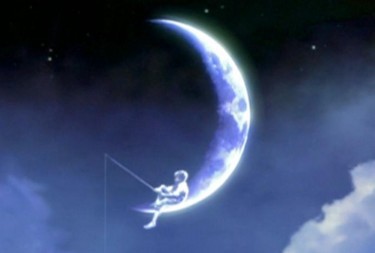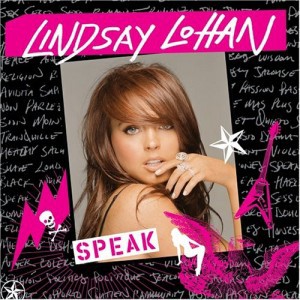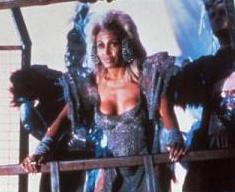23 Terrific Movie Studio Bumpers
by Sharan Shetty

It began in France. In 1895, the Gaumont Film Company (the oldest continuously operated film studio in the world) debuted their “Marguerite” logo, the iconic daisy named after founder Léon Gaumont’s mother. The daisy’s design has evolved since then, and so has the art of “bumpers” — those petite vignettes that announce a production studio’s involvement in a project. Universal and Paramount, the respective second and third-oldest studios in the world, swiftly followed Gaumont’s lead; the latter’s “Majestic Mountain” logo is Hollywood’s oldest surviving bumper, the byproduct of Paramount founder W.W. Hodkinson’s doodle of the Ben Lomond Mountain near his childhood Utah home.
Rarely are they consciously paid attention to, but there’s some serious history to production company bumpers, and they tend to find an uncanny purchase in our collective psyche. Columbia’s “Torch Lady,” Pixar’s jumping lamp, and Warner Bros’ gleaming, golden shield — they’re only ten- or eleven-second commercial visions, surreal images whose sole purpose is to sear their name into the mayonnaise of your brain matter, but they often possess all the magic and mystique of the movies they preface. With that in mind, here are the 23 greatest.
23. Focus Features
My interpretation of how this logo was conceived:
“So, pastel-colored, semi-transparent circles overlapping each other. Solid. But here’s the clincher: We’re Focus Features, right? Let’s put the “O” out of focus!”
“Brilliant. They’ll be gobsmacked.”
22. 20th Century Fox (1994–2010)
Familiar, no doubt. Less familiar, perhaps, is the fact that the intricate fanfare was penned in 1933 by Alfred Newman, who won 9 Oscars — the most for any composer and second-most for any individual. While the bumper’s been updated a few times over the decades, the fanfare has remained the same since 1935. George Lucas liked it so much he urged John Williams to compose the Star Wars theme in the same key (B minor).
21. RKO Radio Pictures
RKO Radio Pictures was one of the “Big Five” production studios of Hollywood’s golden era, and it shows in this faded, old-school logo. The best part: the stilted, intermittent beeps are Morse code for “Attention, attention: an RKO Radio Picture.”
20. Studio Canal (2001–2003)
https://www.youtube.com/watch?v=juSn5dz_74I
Tracers! More importantly, though: WHY ARE THERE NUMBERS? They mean something, right? Why else have the arbitrary inclusion of integers? Or maybe these people are just crazy, which is entirely possible given that they funded the last third of Mulholland Drive.
19. Hanna-Barbera Productions (1979)
It just goes round… and round… and round… such pretty colors….what? Oh, right. The movie. Pass the popcorn, please.
18. Paramount Vantage
If a production company bumper can be postmodern, then this is what it looks like. Paramount’s indie production house has a logo that is a) refreshingly sparse and succinct and b) looks as though Steven Soderbergh directed all whopping ten seconds of it. Seriously though, anything but Paramount’s storied Star-Spangled Mountain Range of Boredom.
17. Dreamworks Pictures
If you aren’t charmed by the surreal fishing scene, the lilting guitar strum gets you hook, line, and sinker. I’ve also always imagined the cherubic little moon-boy-fisher slipping and falling to his untimely death. So has this guy, apparently.
16. Orion Pictures (1981–1996)
A suitably stellar logo for one of the lost giants of the production industry. Between 1984 and 1991, Orion Pictures produced Amadeus, Platoon¸ Dances with Wolves, and Silence of the Lambs. All won Best Picture.
15. Araba Films
Here’s a hidden gem: Araba Films, most notable for their backing of Polanski’s Ninth Gate, was a quaint little Spanish production house. By 2007, however, they had stopped distributing and producing films. Still, the hand-drawn pencil animation here evokes some hidden pastoral paradise, and the music’s a sentimental favorite.
14. Touchstone Pictures (1980s)
The thick, rounded blue line. The tinny synthesizer chiming in your ears. The golden flash of thunderbolt and trumpet. The 80s in general. Yes, this was the perfect logo for its time.
13. ImageMovers
Founded in 1998, Imagemovers is the pet project of renowned filmmaker Robert Zemeckis (Back to the Future, Forrest Gump, etc.), and its logo appears in front of the movies Cast Away and The Polar Express. No doubt inspired by the latter, the oncoming train hits just the right note between mystery and magic.
12. Carolco (1988–1995)
That blue laser illuminating this labyrinth of a logo is just as winding as Carolco’s 20-year reign: they started with massive successes like Terminator 2 and the Rambo series only to collapse into bankruptcy in the late 90s. It was a sudden and screeching descent punctuated by Cutthroat Island, the biggest commercial flop of all time.
11. Lionsgate
For a medium-budget production house, this is some majestic stuff: an enormous chamber with Art Deco overtones, glinting gears and cogs moving in mass synchrony, and a lush symphony rising in the distance. Oh, and metallic doors large enough to be the gates of heaven itself.
10. MGM
Speaking of lions, how about a real one? The ageless Leo the Lion’s roar never fails to rouse the audience from the trailer-induced slumber to which they have inevitably succumbed. Note of interest, though: there have been five lions to grace MGM’s banner, of which Leo, featured since 1957, is the fifth and longest-tenured. Tanner, who served as resident roarer from 1934–1956, is often cited as the most recognized of the five. The first, second, and fourth felines, in chronological order, are Slats, Jackie, and George.
9. Scott Free Productions
Given Tony and Ridley Scott’s penchant for sci-fi and special effects, you’d assume their production house bumper flaunted some flashy CGI wizardry. Instead it’s eerie, organic, and entirely entrancing.
8. Universal
Nothing like our beautiful planet, a thousand points of light, and fanfare fit for a British coronation to imbue what is essentially a commercial with all the significance of the universe and meaning of life.
7. Film District
This short always gets me thinking: what if cities had actual film districts? Classic cinema playing on sides of skyscrapers, sepia street lighting, gargantuan squares dotted with spectators? Take note, city planners of the (distant) future.
6. Pixar
Of the kids who love Pixar, few realize that the lovable lamp has a name — Luxo Jr. — and that he was the eponymous star of Pixar’s very first film, the Oscar-nominated short Luxo Jr. A simple enough concept, but its power probably comes from how much perfection we expect from the movie following it.
5. New Line Cinema (1983–1987)
Before they were an ubiquitous presence in Hollywood, New Line specialized in sleazy grindhouse flicks and cheap thrills. This red-and-black, epileptic opening was used before the popular Nightmare on Elm Street series. The retro surf rock helps the vibe, as well.
4. Walt Disney Pictures
A mundane shot of the sky, clouds floating at the fringes. The camera pans downward, then…BAM! The flag turret of the castle comes into focus, we scale back to a picturesque plain, the orchestra swells to that familiar crescendo, and the audience is, by this point, stupidly smiling at the screen. That’s right, the Nine Old Men are whispering from the heavens: we are Disney, we still have an unyielding grip on your childhood heartstrings, and we’re gonna add a sprinkle of fireworks for good measure. You are putty in our hands.
3. TriStar Pictures (1984–1993)
The newer versions, where Pegasus emerges from a pulsating flash of light, are entirely unsatisfactory. I want to see that heavenly horse trot, goddammit. A few other production houses have adopted the winged steed in their bumpers, but none have come close to matching TriStar’s 80s standard.
2. United Artists (1980s)
There’s not much to say about this, besides the fact that its sick suspense possibly scarred an entire generation. Seriously — it’s like they had a perfectly average sequence, but then decided: “No, wait, let’s slow this down to about a tenth the speed. There ya go. And make the music as disorienting as possible, with offbeat notes on an out-of-tune piano. We want them to wriggle in their seats and have nightmares in their beds.” Genius, really.
1. The Rank Organisation
Perhaps one of the most famous logos of all time, “Gongman” was the renowned mascot for the largest film company in Britain. The man himself? Heavyweight boxer “Bombardier” Billy Wells, chosen by the company as the perfect male specimen. And then handed a huge mallet so he could bang that gong into the annals of history. Classic.
Sharan Shetty is an Awl summer reporter.
New York City, July 19, 2012
★★★ A soothing, even, gray mildness. The balmy air mooted ordinary differences: morning or noon, clothed or unclothed, windows open or closed. The pleasant reverie was broken by few thin, spitting showers; some distinctions — raining vs. not raining — are best kept distinct, after all. A small swarm of gnats, missing the boundary between indoors and out, blundered around the top of the windowpane, toward the bafflingly unreachable light of the sky. Late in the afternoon, wrinkles opened in the cloud cover, sending thin rays of glory down toward the rippling but glassy-looking Hudson. Any July would benefit from an interval like this.
Weather ratings range from zero to five stars.
Awesome Person Honored
https://www.youtube.com/watch?v=Fv8Rhiibix0
“The beauty of the vocal style is that the voice is tender and approachable, not aggressive or threatening, but at the same time the lyrics are powerful and politically charged. It’s a very effective way to juxtapose content and texture. You’ve got a hooky, catchy pop sound, but by the time you absorb the lyrics and get to the chorus, you realize you have been baited and switched.”
— Singer Aloe Blacc talks about the late Curtis Mayfield, who’s 70th birthday, which happened last month, is being celebrated tonight with a tribute concert at Lincoln Center featuring Mavis Staples, The Roots, Meshell Ndegeocello and Sinead O’Conner, who will likely do this:
And maybe Mavis Staples will do this (having done it before):
And the Roots will probably do something like this:
And if we’re lucky, Meshell Ndegeocello exactly this:
Listening To Lindsay Lohan's 2004 Debut Album
by Mike Barthel

If everyone you know is making an album, is it really a vanity project when you make one, too, or is it just peer pressure? Such is the taxonomic problem with which we’re faced when it comes to Speak, Lindsay Lohan’s 2004 Casablanca Records debut LP. While previous entrants in this series may have made their albums at the behest of savvy record labels, as with Ian McShane and Milla Jovovich, or to satisfy their own artistic ambition, as with Corey Feldman and Crispin Glover, the years surrounding Lohan’s album would see releases — some very good ones, it should be said — from peers like Paris Hilton, Mandy Moore, Ashlee Simpson, and Hilary Duff. Releasing a teenpop album was simply what you did as an up-and-coming starlet in the mid-aughts. Some of these artists have gone on to sustained careers, but others’ efforts have stood alone as the one- or two-off cash-ins that have characterized teen stars since time immemorial (i.e., the 50s). Of course, cash-ins like Speak have as much of a chance of being a high-quality album as anything else. But does Lindsay’s album rise to the occasion?
THE SONGS: As was the style at the time, all are fresh originals either peeled from the stack of producer demos floating through the laptops of A&Rs; worldwide, or written specifically for the album. Lohan receives co-writing credit on five of the twelve tracks, including the big one, “Rumors,” which is, sad to say, not a cover of the entire Fleetwood Mac album compressed into three minutes and sixteen seconds.
THE PACKAGING: God, that cover — it’s just awful, isn’t it? Seen from a distance Lindsay appears to be staring upward and biting her finger like someone pretending to be an airhead; once you get in close the full eyelock emerges, but then you notice everything around the picture. It’s like the designer was trying to win an award for sub-Avrilisms, or was rushed for time and used Blingee instead of Photoshop. And what is that written on the fake notebook paper? “Passion,” OK, that makes sense, “peace,” “religion,” “sex,” gotcha loud and clear. But “plug”? And all the random French words, some next to their English equivalent? Or is “politics / politique” meant to refer to the seventeenth-century wars between the Huguenots and Catholics? Inside, the rest of it’s fairly standard-issue stuff if you’re familiar with Lohan’s moving-beyond-Disney-but-still-kinda-Disney media image in 2004 (Lindsay slings a guitar, Lindsay looks provocative in a white shirt, Lindsay wears a tan golf cap for some reason), but taken with the cover the whole thing is baffling. It’s like someone who’s never met a teenage girl was locked in a room and told he couldn’t come out until he’d designed something that would appeal to teenage girls.
DID IT SELL?: Yep: #4 on the US charts and platinum domestically, plus another million and a half worldwide.
CURRENT AVAILABILITY: Still in print.
SKETCHINESS OF LABEL: So-so. Casablanca released albums by Kiss and Donna Summer in the 70s, but was shuttered from the mid-80s until 2000, when it was relaunched by Universal honcho Tommy Mottola to some fanfare. Aside from Lohan and a couple of other artists, though, it failed to find an audience and went quiet again in 2009.
MOST HILARIOUS QUOTE FROM AN AMAZON REVIEW OF THE ALBUM: “Jennifer Lopez is without question a below-average vocalist, but miraculously managed to sell millions of albums. She succeeded during a time where sex appeal was everything, and talent was not a necessity — which also explains the stunning success of lip-syncing flunkies like Spears.” (This is a quote from a review of the Lindsay Lohan album.)
WHO MADE IT: The songs come from some of the bigger producers of the day, like Andreas Carlsson of “I Want It That Way” fame, but almost every track on the album was produced by Kara DioGuardi and John Shanks. (Lohan’s original idea for her debut album was to work with Gloria Estefan’s husband, but sadly, that didn’t pan out; she’d also briefly considered working with Randy Jackson and Diane Warren.) Before DioGuardi was a judge on “American Idol,” she and Shanks produced a remarkable number of The Albums That Sound Like That From The Mid-00s. They were the power behind the throne of the guitar-heavy flavor of teenpop. The sound is a sort of amalgamation of everyone on MTV’s “Total Request Live,” the Rosetta Stone of pop music from 1999 to 2006, and while the sound is most widely known from production team The Matrix’s work with Avril Lavigne, DioGuardi and Shanks were the ones who made it work everywhere. If you take the Swedish electro-pop of Britney Spears and the Backstreet Boys, add in both Blink-182’s pop-punk and KoRN’s pop-metal, and throw in the occasional bit of Shania Twain or Sheryl Crow’s pop-country, you get the DioGuardi/Shanks formula. It was versatile enough to work for both Ashlee Simpson and Bon Jovi, and briefly brought guitar music back into the mainstream. The songwriting scene of the mid-aughts was mobile and versatile (the Matrix made their own album as artists, which Katy Perry was a co-writer on pre-”I Kissed a Girl”; Lady Gaga co-wrote with production team RedOne of “Starships” fame before she made The Fame; DioGuardi got another reality show on top of Idol, “Platinum Hit”), and was part of what made being a pop fan during that era so much fun.
WHEN SHE MADE IT: Let’s put it this way: Mean Girls came out in 2004. If you know Lindsay, you know that was about the peak, after which things started to go downhill. Speak, in many ways, is a better marker of her high point: this is where all the rumors start. During production of the album Lohan had her first hospitalization, for a kidney infection supposedly brought on by stress. She had been working in her trailer to finish the album, which was overdue, at the same time as shooting Herbie: Fully Loaded in 110-degree heat; she was also dating Wilmer Valderrama, which eventually got her cut out of the marketing of the movie due to her un-Disney-like private life. (Imagine if no one who dated Wilmer Valderrama was allowed to make movies! What would our movies look like?)
“Ah, la Belle Epoque!” my wife exclaimed when I asked her to help me reconstruct Lindsay’s 2004. In the period between the crashes of 2001 and 2008, it was an era when clubs would let in 17-year-olds because they were stars, and that seemed exciting to us; an era before we’d seen the same pattern repeat itself again and again for several of Paris Hilton’s ex-friends, before avoiding such a fate became obvious. A 2006 Vanity Fair article about Lohan (the “it’s like, yeah, motherfucker, I’m fine” one) describes her extracurricular activities in the period:
She started shopping like a Trump wife. (She confesses that she dropped $100,000 in a single day.) With Paris, Nicole, or an Olsen twin in tow, she started hitting the clubs-Mood, Concorde, and Marquee-the sort that lavish free drinks on celebrities. She became a staple of the tabloids, which was how some family members were now getting their information about her. “I remember my sister called me up: ‘I heard you got Pamela Anderson boobs.’” And she now admits she began using drugs “a little,” but quickly says, “I’ve gotten that out of my system.”
She also got into a feud with Hilary Duff because she was dating her ex-boyfriend, Aaron Carter. It was a weird time. Eventually she would piss off Paris Hilton, and Paris’ then-boyfriend Brandon Davis would call her “firecrotch,” but that was 2006, still a ways off. Her father was essentially stalking her. By 2005, Lohan’s eating disorder was evident enough that Amy Poehler sat her down for a talk. Lindsay grew up as a middle-class kid on Long Island with a troubled family, got some money all of a sudden, and moved to LA to live the good life, only to run into a group of rich kids who were only too happy to help her ruin her life, apparently because they had nothing better to do. We’ve all been there, now.
THE MUSIC: Has it been long enough since the teenpop boom that we can avoid damning it for its celebrity associations? Do we now realize, finally, that the problem wasn’t really Lindsay Lohan or Britney Spears? If so: the album is only OK. There are far better ones in the genre; try Dave Moore’s epic teenpop overview for pointers on which, if you’re so inclined. The standout “Symptoms of You” is a ballad that slips between waltz time and a straight-beat guitar crunch. That crunch sounds pretty familiar, but Lohan’s voice works great for the energetic melody and the lyrics about romantic self-destruction. Her voice, much-mocked since it began roughening into a Leonard Cohen rasp, is perfect for music about being sad, and it’s a pity there’s not more of this. The country tunes here work the best by far. She’d make another album, 2006’s Raw (A Little Personal), but she was a little too unhappy then. If her movie career has been less than exemplary of late (she’s starring in a Liz Taylor biopic, sure, but it’s for Lifetime), I don’t think we’d be unhappy for Lindsay to re-launch her musical efforts, maybe with a collaborator better able to capture her ragged edges. Until then, though, Speak doesn’t speak very well for itself.
Note: Article’s been corrected to reflect that Mandy Moore started her career as a singer before transitioning to acting, not the other way around.
Previously: Ian McShane’s From Both Sides Now, Corey Feldman’s Former Child Actor, Milla Jovovich’s Divine Comedy, Cornel West’s Sketches of My Culture and Crispin Glover’s The Big Problem ≠ The Solution
Mike Barthel has a Tumblr.
"Thunderdome" Unveils "National Curation Team"

“Digital First Media announced today that it is creating a national curation team as part of its centralized news operation. That operation, called Thunderdome, will be produced by Digital First’s MediaNews Group and Journal Register Company…. ‘Providing context to everything we curate is vital to providing a comprehensive news report,’ said digital projects editor Mandy Jenkins…. ‘Successful curation… will entice many people to click through and read or watch more,’ wrote Steve Buttry in a blog post. Buttry is the director of community engagement & social media at Digital First, and he pointed out some useful guidelines and tips for curators in the post. ‘Effective curation boosts the experience of each of the pieces by presenting multiple pieces in a context that enhances your understanding of each piece,’ he wrote.”
— Ever feel like you’re walking down the street and suddenly a shimmering window appears into an alternate universe where the sky is green and the words all mean different things? That’s what this press announcement was like for me.
Uplifting Animal News of the Week

• “State wildlife officers have rescued a manatee believed to be only two to three weeks old from the basin behind the government and cultural center in Key Largo.”
• “A love story: A man, a dog and the bridge that came between them.”
• “The resilient cat Wollie traveled about 6 miles from the Animal Rescue League to its Bedford, N.H. home. The 3-year-old cat spent three days on its odyssey back to the couple that loves him.”
• “The award-winning animal trainer William Berloni on Thursday unveiled the pooch who is slated to star in the Broadway revival of the Tony Award-winning musical ‘Annie’ — Sunny, a 2-year-old female terrier mix rescued from a city pound in Houston. Sunny was only 24 hours away from being euthanized four months ago when Berloni spotted her photo online while conducting a nationwide search for Sandy.”
